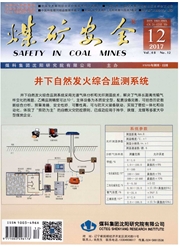

 中文摘要:
中文摘要:
为了分析高压电脉冲致裂作用特征及其对煤层气开发作用,以混凝土试样为试验对象,研究了无应力状态下试样裂隙分布特点及其扩展特征。结果表明,高压电脉冲对试样具有明显的致裂作用;经过高压电脉冲作用后,试样表面出现裂隙网络,其中主裂隙数目为2~4条,长度为25~32cm;试样裂隙从钻孔周围开始,其扩展过程可分为应力积累、缓慢发展、快速发展及破坏4个阶段。高压电脉冲通过液电效应产生的冲击波对试样进行破裂作用,同时冲击波引起的水楔效应等对煤体裂隙的生成也有促进作用。高压电脉冲能够改善瓦斯流动情况,从而提高煤层气产量。
 英文摘要:
英文摘要:
In order to study the action characteristics of high-voltage electrical pulse(HVEP), an experimental system was developed and some concrete samples were made, the distribution and extension characteristics of cracks under non-stress were studied.Results show that HVEP has a positive influence on producing cracks in samples. After the action of HVEP, the crack network appears on the concrete samples, the number of main cracks is between 2 to 4, and the length is 25 cm to 32 cm. The cracks start from the hole of samples and the generative process of cracks can be divided into four stages, stress accumulation, slow development, rapid development and failure stage. The shock wave produced by liquid-electric effect of HVEP has a major role on fracturing samples, and the water-wedge effect can also promote the coal fracturing. After the action of HVEP, the flow degree of methane is improved, so the technology can encourage the exploitation of coalbed methane.
 同期刊论文项目
同期刊论文项目
 同项目期刊论文
同项目期刊论文
 期刊信息
期刊信息
